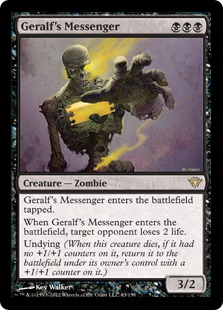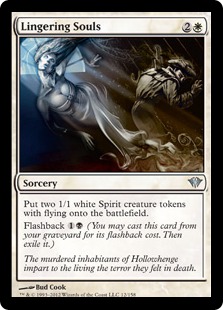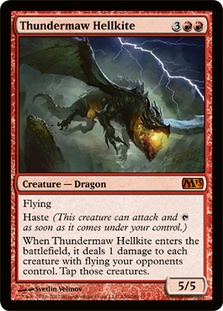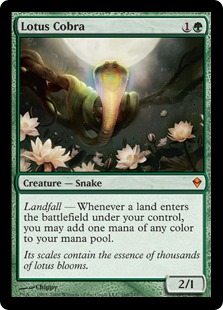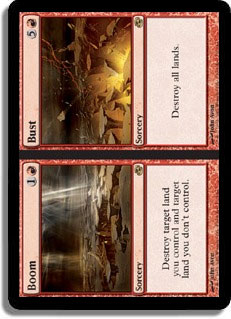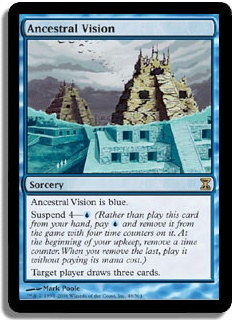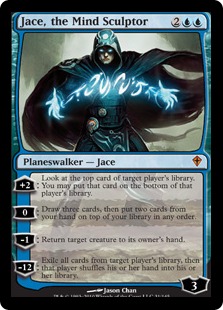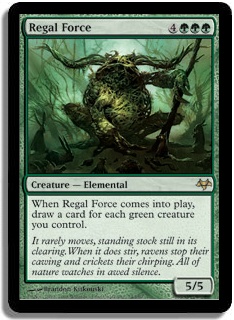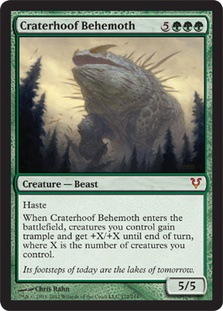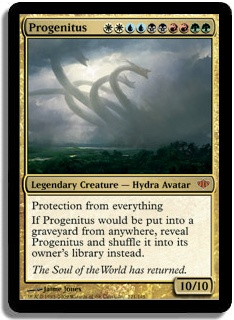You can get addicted to a certain kind of sadness
Standard isn’t what it used to be.
Obviously, formats tend to change over time. This one is no different; ranging from blistering fast aggro decks to glacially slow control decks, it feels like there is a different best deck each week. As for me? I feel like I’m stuck on tempo decks, and I don’t know how to break the cycle.
I’m not against aggressive decks. I’ve been known to throw the occasional Lightning Bolt at my opponent’s face, but I’d like to flip a Delver of Secrets and attack with that while I’m doing it. Blue is by far my favorite color because it gives you the most options. In a game like Magic, there is nothing worse (to me) than relying on the top of your deck to save you.
Of course, every draw step is going to ultimately help you accomplish your goals. Blue just helps you manipulate that to your advantage at the cost of other resources (mana and life). While you aren’t necessarily winning a lot of the games where you are manipulating your deck, it does help you find the answers to whatever problems your opponents are throwing at you. At times, this expenditure of resources will result in you falling too far behind to catch up, which is basically the problem in the first place.
But what is an appropriate cost for happiness?
U? 1U? 1UUU?
I couldn’t tell you exactly, but I do know that there is very little like using Shardless Agent to cascade into Ancestral Vision. They only show scenes like that on Showtime past 9 PM, buddy.
But seriously, blue is generally regarded as the “best” color because it is usually the color chosen by the better players in a given tournament. This fluctuates based on format, metagame, and various other factors, but blue is the best color because the best players like to play blue. Sounds stupid, I know.
That’s probably because it is.
Blue is a fine color, but it shouldn’t be the end-all be-all. Lately, the rest of the color pie has been beating blue decks senseless. Ranging from Naya to Jund to Rakdos, there doesn’t seem to be a Geist of Saint Traft in sight!
Maybe it’s time for me to find something better to do than cast Think Twice.
When we found out that we could not make sense, well you said that we’d still be friends
While I’m not ending my love affair with blue, I think I’m going to set it down for a bit. Try some new things. Work my way around the local bar scene and see what Unburial Rites has been up to. It’s been a while since I’ve been on the dating scene.
With a Standard Grand Prix coming up this weekend, I honestly wish I could tell you what the best deck to play is, but I can’t. It probably involves casting gigantic monsters and using Cavern of Souls to give the big middle finger to the blue decks, which seems fun, but it’s actually like watching paint dry. Maybe I can find something somewhere in the middle that doesn’t make me want to find a fork and an outlet.
As for the other Constructed formats, I’ve been playing a ton of both Legacy and Modern, so we’re going to focus a bit on those. For the last few weeks, I’ve taken a break from writing to do some traveling to see family and spend the holidays in Birmingham, but I’m back and finally ready to settle back down into my groove.
As far as Modern is concerned, there is basically only one deck that you need to know about above all others regardless of whether or not you are piloting it.
“Jund,” or whatever you want to call the four-color good stuff configuration, is the best deck in the format. It combines the best disruption and best aggressive creatures into one shell, giving you the best “fair” deck possible. Counterspells aren’t reliable enough, and they force you to constantly leave up mana to protect yourself, which usually makes you incredibly vulnerable for one turn out of every game so that you can put a threat out on the board. The discard effects in Jund only require that you spend one mana at basically any point in the early turns of the game to slow your opponent down long enough for your Tarmogoyfs and Dark Confidants to take over.
In actuality, Jund is the “good guy.” Has the best deck in a format ever been the good guy before? You aren’t doing anything incredibly broken, and your cards just generate marginal advantages over and over until your opponent dies. Sure, they can win on turn 3 or 4, but Bloodbraid Elf is sweet! Deathrite Shaman gave Jund a way to speed up significantly, but did it really bump it above everything else in consistency?
What is going on here?
Like resignation to the end, always the end
Jund has won two Modern Grand Prix, made the finals of the Pro Tour, and has won nearly every Magic Online PTQ. While I don’t think the deck is “too good” and deserves for something to get banned, I do think the deck is incredibly efficient and should be scrutinized. What is so fascinating to me is that the deck continually evolves to be better against the expected metagame.
Maybe this means we should all be playing Jund.
Many people didn’t figure this card out at first and came to Pro Tour Return to Ravnica without it in their 75. Out of all the cards that RTR brought to Modern, I think Deathrite Shaman was the most important, and the fact that a lot of people didn’t figure out how good it was until multiple weeks/months after it had been legal is a testament to both its design and subtle strength.
Deathrite Shaman is a “value” card, and we want value cards in decks like Jund so we can gain incremental advantages every turn until our opponent dies. That’s the definition of a “fair deck.”
In the beginning, people thought that Geralf’s Messenger would be the best card for the mirror since it’s also much more aggressive than Kitchen Finks against the rest of the decks in the format. This coupled with Deathrite Shaman to form the “best” version of Jund at the Pro Tour.
As time progressed, people began to figure out that getting value wasn’t enough! We had to get “more fair.”
You make some guys. You flash it back and make some more guys. What’s new? Oh, we added another color for a card that is only marginal in Standard, you say? Of course, Lingering Souls is an all-star in various decks across multiple formats, and I think it is safe to say that it is no exception here in Modern Jund decks. It’s a way to beat opposing Lilianas gives you the best chance of beating the mirror while losing little in other matchups. Lingering Souls isn’t a bad card by any stretch of the word, but it finds a nice home in Jund, even when it only sees play as a two- or three-of.
While Thundermaw Hellkite has jumped in price constantly since the release of RTR, I never thought it would see play in Modern! With decks that can consistently combo off or cast Karn Liberated on the third turn, I wouldn’t expect a five-mana creature that doesn’t win the game on the spot to really do anything. But these are strange times, and Jund does some strange things to people.
When most of the combo decks in the format are being stifled by discard and the metagame is full of fair decks, whoever has the trump card wins. Lingering Souls is one of the better trump cards at the moment because it dominates an opposing Liliana, which was just malicious before. With Lingering Souls cluttering up the board, we need a new way to beat it.
I think that, along with Maelstrom Pulse, Thundermaw Hellkite is a fine answer. I wouldn’t play too many, as it hurts you pretty bad when drawn off Dark Confidant, but it can be an absolute blowout and gives you an edge in the games when you draw it late. There aren’t too many good topdecks that really punish Jund in Modern since so many decks need to amass cards to pull off some sort of structured game plan. Your removal and discard usually boxes them into a corner, and they generally need multiple topdecks to get out of various situations. With more cards like Thundermaw Hellkite and Baneslayer Angel seeing play, things could end up getting a little bit worse for Jund.
These two cards were used by Matej Zatlkaj (BigZ) to win a Magic Online PTQ. With so many fetchlands, you can use Boom / Bust to great effect as a two-mana Stone Rain or the occasional Armageddon off Bloodbraid Elf. Both modes seem decent enough, but what about Lotus Cobra?
I’m not sold that Lotus Cobra is a better two-drop than Dark Confidant. If either survives to untap, I think that your overall win percentage is greater when it is Dark Confidant as opposed to Lotus Cobra. I do understand the appeal of doing “bigger things” when few people are trying to play combo decks against you and I like being able to out-mana your opponent on the regular, but cutting Dark Confidant doesn’t feel like it should be the answer.
I will be playing Jund in PTQs from here on out until someone gives me a good reason to play something else.
I wouldn’t catch you hung up on somebody that you used to know
Enough about Modern. Let’s talk about some cards that aren’t legal in Modern and are legal in Legacy!
Of course, everyone except Tomoharu Saito knows what Jace, the Mind Sculptor does, but I’m sure some of you haven’t seen Ancestral Vision in play for quite some time. With Legacy slowly turning into a format where you can play fair again, it is pretty safe to assume that the games are going to slow down a lot. This ends up making cards like Ancestral Vision workhorses, as there really isn’t all that much card advantage in Legacy.
Brainstorm and Ponder are efficient at card selection, but neither gain you that much of an actual advantage. Brainstorm can shuffle away excess lands, but what happens when you actively want to draw lands in your control deck? You can’t shuffle away lands and spells, right?
With the printing of Planechase “I love Gerry Thompson” 2012, we gained access to Shardless Agent.
But isn’t Shardless Agent just a combo card that goes into Hypergenesis? I don’t know. Is a Bloodbraid Elf that costs less mana and can be used with Force of Will good?
Explain your work.
To be honest, I don’t know for sure if BUG is a good choice for upcoming events. While the deck is certainly playable and can probably be very good, I’m not sure if the metagame is quite right for it. The discard spells can occasionally feel clunky, and I’m generally not a fan of mixing counterspells and discard spells anyway.
I also really like cheap disruption like Spell Pierce instead of discard effects since they force your opponent to spend most of their turn doing nothing. With discard effects, they can come back with the top of their deck or just have multiple things in hand and plenty of time to resolve everything.
The problem is that you can’t actually have these spells in your deck thanks to Shardless Agent.
Cascade is a tricky mechanic because it chokes your card selection on occasion. Obviously, you want to make the card as good as you possibly can without playing a “bad deck,” but there comes a point where you just have to decide which direction you want the deck to go. At the end of last year for the Invitational, I was fairly certain (after getting my butt kicked with it) that BUG Control was the deck to beat and anyone who wanted to beat it would have a very tough time unless they were a streamlined combo deck with a ton of protection.
Those decks do exist in Legacy, but with everyone playing Force of Will, it becomes much harder for them to function. They can still combo off through Force of Will with protection like their own Forces, Duress, etc., but the tension is still there. Sometimes the combo decks just lose to themselves. Sometimes they lose to an outrageous amount of hate or disruption.
Sometimes they win.
But I’ll admit that I was glad it was over
Regardless, I think that Legacy is currently a format in which you can play basically whatever you want. I can only say that I am very happy that Natural Order is playable again, though I am sad that it is in the Elf combo shell!
These baddies make Natural Order quite solid in a lot of matchups, which is pretty awesome for a deck like Elves that can attack from multiple angles. With Craterhoof now in the deck, it becomes much easier to kill them quickly when you can’t just combo them out.
Of course, it is difficult to play a deck like Elves where you are a mix of both aggro and combo but do neither with all your heart. Rather, you can do either and should pick whatever plan is better for each spot that your opponent puts you in. You’re never cold to Force of Will because you can just go into attack mode, and your opponents will almost always be much more worried about Glimpse of Nature than Natural Order, leading to some pretty hearty blowouts. I’m not sure what the best deck in Legacy is, but I may or may not be asking around for some Portal Natural Orders at the next Legacy event I go to…
It has been too long, my friend.
The Soul of the World has returned!
Thanks for reading.
strong sad on Magic Online
@strong_sad on Twitter
P.S. Roll Tide!


